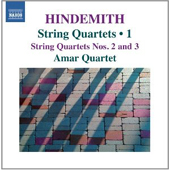
ESSENTIAL RECORDINGS

Paul Hindemith (1895-1963) could certainly be viewed as one of those perplexing casualties of time and caprice. An important musical
figure during the first half of the 20th century, and now almost completely ignored. A busy German composer, violist, teacher, conductor and writer,
who also lived and worked in Turkey, Switzerland and the United States, where he was actually one of Leonard Bernstein's teachers. He was the soloist
for the 1929 world première performance of William Walton's Viola Concerto, as well as being one of Furtwängler's favorite composers.
But yet these days, his name hardly ever comes up within musical circles. I myself have been a witness to his neglect. During the many years I spent
managing record shops, I would always notice that the Henze and Holst sections, surrounding Hindemith's were always picked at and required constant
restocking, while the Hindemith titles remained untouched. The only work of his that has seen a sizable number of recordings is the Mathis der
Maler Symphony.
His String Quartets in particular, and one has to wonder why, have not received the exposure they deserve. Hopefully this excellent new recording by the
Amar Quartet, the first in a projected release of all seven of Hindemith's quartets, will generate enough interest and in turn shed
more light on this composer's output. The String Quartet No. 2 in F minor, Op. 10 was written in 1918 whilst he
was a soldier on active duty. During his military service, Paul Hindemith played the bass drum in a military band behind the front lines, and also
took a seat in an all-soldier string quartet. It clearly demonstrates this composer's no-nonsense approach to music, where the brain rules the heart,
and melodic and harmonic development are more important than emotive expression. Although this is not always so clear cut, when you consider
some of the unusual aspects he introduces within the framework of his music. For example, this quartet begins in a style steeped in tradition and a
positive outlook, until at the 2:25 mark he introduces a strange, ghostly and macabre fugue that eventually dissolves and returns the music to its
previous state. The final movement is an impressive display of complex counterpoint, intricate tonal development, all very well counter-balanced by
a beautifully lyrical central section, expertly rendered here by the Amar Quartet. The final two minutes alone of this quartet should
be enough to convince anyone of this composer's talents.
The String Quartet No. 3 in C major, Op. 16 from 1920, opens Lebhaft und sehr energisch (Lively and
very energetic), and again makes clear Hindemith's ease at manipulating four freely independent lines into believing they are one. The cohesiveness
of the music belies its extremely complex counterpoint. The Amar Quartet members shine in this movement. The following slow movement proves that,
even though he wouldn't admit it, this composer did have an expressive side. It is again also marked by some strange gestures, like those very soft
long, recessed glissandos in the middle section. The final movement is characterized by innovative ideas and techniques, marked by an intricate layering
of all four lines, giving the music a larger-than-life demeanour.
Anna Brunner (Violin), Igor Keller (Violin), Hannes Bärtschi (Viola) and Péter
Somodari (Cello), are the musicians who constitute the Amar Quartet. In 1922, Paul Hindemith founded a quartet named after
its violinist Licco Amar. On the occasion of Hindemith's 100th birthday in 1995, the Hindemith Institute awarded this Zürich-based chamber ensemble
the historic name. They've already released a dozen recordings covering everything from Haydn to Ullmann, including some Hindemith in between,
and based on what I hear in this present Naxos recording, they can carry their name with pride.
Jean-Yves Duperron - June 2012